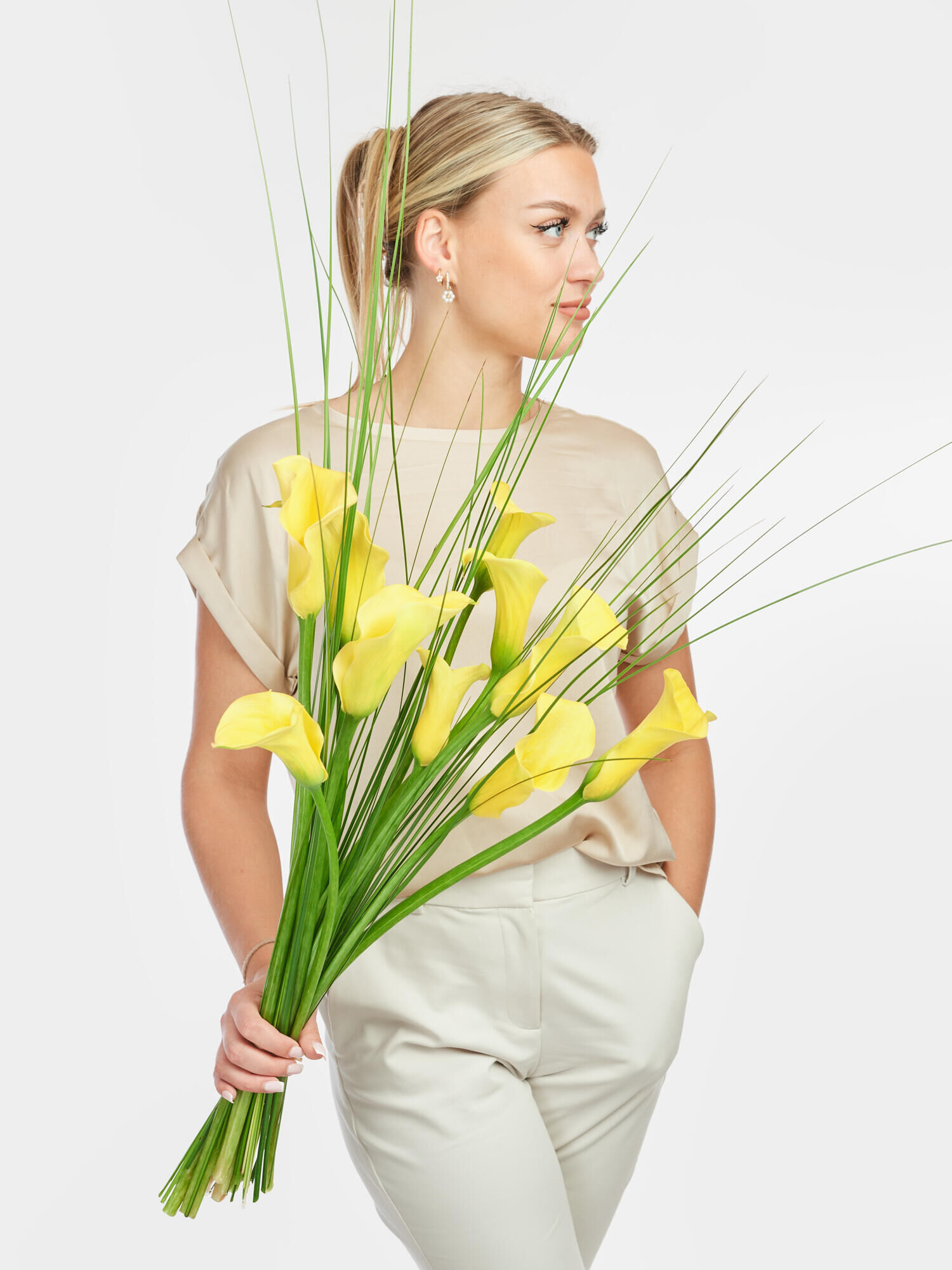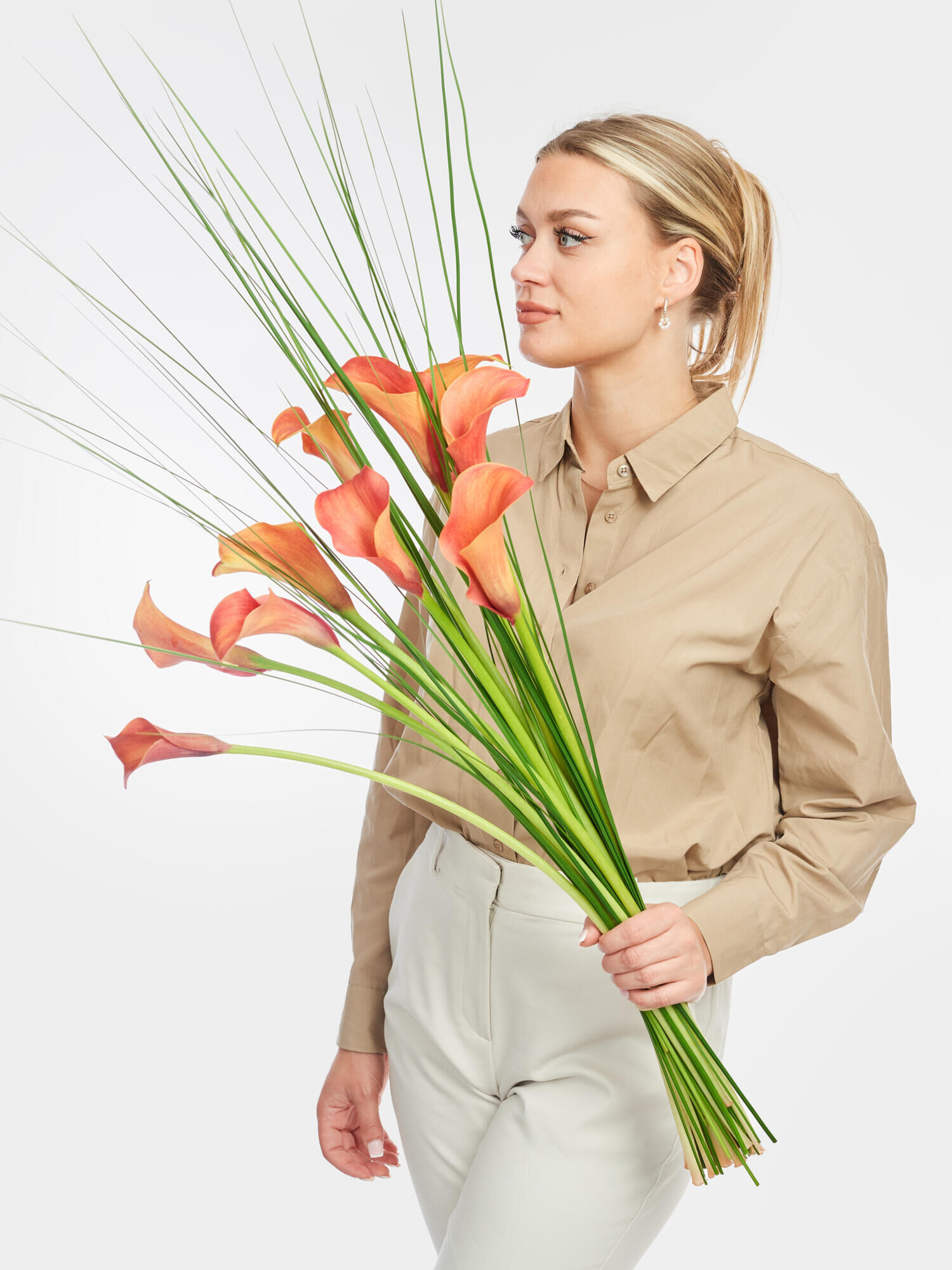Calla Lily Care: Growing and Caring for Zantedeschia

With its arrow-shaped foliage leaves and funnel-shaped perianths, in which yellow pistils form, the calla is a decorative, beautiful houseplant and can also adorn balconies and terraces in summer. It is also available under the name Zantedeschia and grows from a tuber. Its stems can also be found in the cut flower range, from white to shades of purple.
The most important facts about the plant family
Botanical name
Its botanical name is Zantedeschia. It belongs to the Araceae family, the arum family. There are only eight species, although numerous hybrids have been bred.
Origin
Zantedeschias originate from South and East Africa. Thanks to their thick and fleshy rhizomes, they live on riverbanks and lakes where dry periods cannot harm them.
Flowers: flowering time, colour & shape
The inflorescences of the calla consist of a perianth (spatha). The actual small flowers sit on a yellowish spadix, which is enclosed by the perianth. The inflorescences stand above the foliage leaves and can grow up to 100 centimetres high.
In our latitudes, the calla blooms in spring. The individual inflorescences are attractive for a long time, around three to eight weeks.
Thanks to many cultivars, many colours are available in addition to the original white bracts, from cream and yellow to orange, red and purple.
Fruits: The calla produces spherical green or orange-coloured fruits that look like berries. They contain the seeds. However, calla as a houseplant is usually not pollinated, so that no fertilisation takes place and no fruit is formed.
Calla varieties
The well-known "common calla", botanically Zantedeschia aethiopica, is used for pot and cut flower cultivation.
Zantedeschia jucunda is often offered as a garden plant.
The golden calla (Zantedeschia elliottiana) flowers from June to August and is sold as a cut flower from the greenhouse all year round.
Zantedeschia rehmannii grows to a height of 30 cm and flowers in pink or bronze colours.
The variety 'Crowborough' is worth mentioning from the wide range of varieties, as it is fragrant and considered hardy.
Zantedeschia aethiopica 'Perle von Stuttgart' (30 cm high) is one of the smaller varieties. Zantedeschia aethiopica 'Green Goddess' grows 60 to 90 cm tall and delights with large, creamy white to yellow-green, fragrant flowers. The variety 'Cantor' has dark red to black bracts.
What is the significance of the calla flower?
The calla is considered noble and is offered as a "flower of purity", of sympathy and as a lucky charm. Giving a calla as a gift is an expression of admiration. As a symbol of eternal life, calla lilies are used in funeral floristry. But the flower also expresses appreciation and admiration at weddings.
Care in the garden - How do I care for a calla plant?
Location
As a houseplant, the calla should be given a sunny to semi-shady spot, ideally at around 20 degrees Celsius. In summer, it also shows its best side on balconies and terraces if it is reasonably sheltered. In winter (dormant season), temperatures between 10 and 15 degrees Celsius are sufficient.
Watering
The calla needs plenty of water during the growing and flowering period. After a thorough watering, the run-off water can remain in the pot or saucer without causing any damage. After flowering, however, watering should be reduced.
Fertilising
During the growth phase until the end of the flowering period, it is advisable to fertilise every fortnight with a liquid fertiliser. This will stimulate the calla's flower formation and help it to grow successfully. Fertilising is not necessary during the dormant phase in winter.
Pruning - cutting back the calla
A calla does not need pruning. Leaves that are brown and dead should be removed. Vital leaves should not be cut, as the plant draws its nutrients from them. Flowers can be used as cut flowers and offer a long vase life.
The calla usually flowers from June to August, after which no more new flowers are produced. After flowering, stop watering and allow the substrate to dry out completely. Now the dormant phase begins.
Overwintering calla
With the start of the dormant phase, which usually occurs in October when the substrate is completely dry, the plant is placed in a cool, dry and frost-free location.
Due to its origin, the calla is usually not hardy. There are a few exceptions. The variety 'Crowsborough', for example, is hardy to minus 20 degrees and can remain in the bed with winter protection.
A calla can be overwintered in its pot. At the start of the dormant phase, when the substrate is completely dry, the plant should be placed in a cool, dry and frost-free location.
How to propagate calla
If you want to propagate a calla plant, you can divide the rootstock of an older existing plant. It is ideal to divide the plant when you want to repot it anyway.
The division is done like this: The roots are exposed from the substrate. Then take a sharp knife and cut sections from the existing rhizome. These sections are planted four or five centimetres deep in a fresh substrate. Ideally, potting compost should be used for this. The freshly potted calla should only be watered a little. Watering should only be increased as new shoots emerge.
Sowing from seed is also possible for pure callas. However, it will then take a few years before the first flowers appear.
Calla tubers or rhizomes (rootstocks) are ideally planted in humus and nutrient-rich substrate in early spring (March). The pots should be placed in a bright position, but not in full sun.
The ideal potting date is early spring (March). However, calla tubers can also be planted in autumn.
The calla tubers or rhizomes (rootstocks) should be planted around 10 centimetres deep.
Calla rhizomes are overwintered frost-free.
The tubers / rhizomes are planted flat side down.
Callas in pots - how do you care for callas in pots?
If the calla is kept as a potted plant, it should be fertilised with a liquid fertiliser (every fortnight) during the growth and flowering period.
It does not need to be pruned, it is sufficient to cut back wilted leaves and flowers at the base of the stem with a sharp knife.
Common pests & diseases
Brown leaf tips appear on the calla if the humidity is too low.
However, if this is too high, it can lead to fungal diseases. Aphids and spider mites are observed if the plants have been given too much nitrogen. Aphids and spider mites spread particularly in the winter quarters. Regular checks for pests should therefore be carried out.
Root and tuber rot can be prevented if the plants are not too wet.
Frequently asked questions about Zantedeschia
Callas belong to the arum family and all parts of the plant contain a milky liquid that contains toxins. These toxins can cause skin reactions and mucous membrane irritation on contact.
If you grow your calla in a pot, you should repot the plant every two to three years.
If the plant does not flower, this is usually due to a lack of flower induction, which is triggered in the calla by a cold stimulus. It is important to observe the dormant period and place the calla at lower temperatures.
A lack of flowering can also be observed in a young plant that has been grown from seed. It takes a few years for callas grown from seed to flower.

















